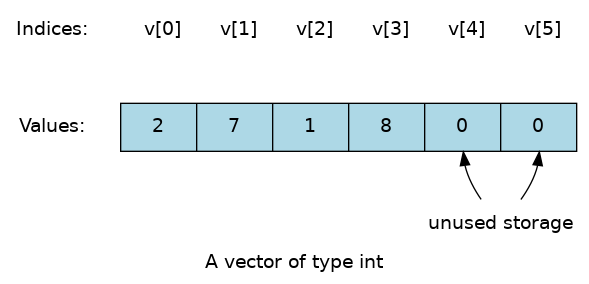11.1. The std::vector class¶
The std::vector is a sequence container that simulates a dynamically sized array. If you have taken a class in linear algebra, the vector ADT has nothing to do with mathematics, but is simply sequential data structure.
It is a flexible and frequently used container. Refer to The vector class for an introduction to the basic functions available.
Like an array, elements are stored in adjacent memory slots. This means that elements can be accessed not only through iterators, but also using offsets to regular pointers to elements. The benefit of this is that a pointer to an element of a vector may be passed to any function that expects a pointer to an element of an array.
Unlike an array, vector storage is handled automatically, being expanded and contracted as needed. Vectors usually occupy more space than static arrays, because more memory is allocated to handle future growth. This way a vector does not need to reallocate each time an element is inserted, but only when the additional memory is exhausted. The total amount of allocated memory can be queried using the capacity function. Starting in C++11, extra memory can be returned to the system with a call to shrink_to_fit.
A vector declared as:
std::vector<int> v(6);
Creates a vector of type int,
with size 6 and all values initialized to 0.
At this point, the size and capacity of the vector are the same.
If we assign new values to the vector:
v = {2, 7, 1, 8};
The new values replace the old. Although the size of the vector lowers from 6 to 4, the capacity of the vector is not changed.

The data at v[4] and v[5] were originally default constructed
and accessible when the vector was initially created with the explicit
size = 6.
Once the new data is assigned and the size of the vector is reduced,
the end() also shrinks.
A loop over the elements in the vector will not include
the data at v[4] and v[5].
Try This!
Change the previous example using different ways of initializing and
modifying the vector.
Try to predict the print output before running the program.
Some things to try:
Default constructed vector
Push back 1 value onto an empty vector.
Write a loop to push back 10 values onto a vector 1 at a time.
Replace clear with empty
Calling vector::reserve with values larger and smaller than the current capacity.
This is a new and important distinction.
- size
Refers to the number of elements in the container.
- capacity
Refers to the total size of the underlying storage.
The vector ADT makes the distinction primarily for performance reasons. The backing store of a vector is an array and an array cannot be resized. Adding even one element to a completely full array involves several steps:
making a new array with a larger capacity
copying the old array into the new array
destroying the old array storage
That is a lot of work and a potentially expensive operation. For this reason, vectors normally never reduce the capacity of and array unless explicitly instructed to do so.
It also explains why tools like clang-tidy will
complain
if it finds calls to vector::push_back
in a loop after a default constructed vector is declared.
11.1.1. Passing vectors to C functions¶
The data layout of a vector makes it easy to pass a vector to a legacy C function that expects a raw array. This is something that comes up more often than you might expect. The book Effective STL has a good discussion of passing string and vector objects to legacy C functions[1].
Given a legacy C function that expects a raw array:
void print_sum (const int* values, size_t array_size) {
int sum = 0;
for (size_t i = 0; i < array_size; ++i) {
sum += values[i];
}
printf("Sum of ints in the array is %d\n", sum);
}
We expect to be able to pass in an array and print the sum:
int main() {
int data[] = { -30, 102, 55, -19, 0, 222, -3000, 4000, 8, -2 };
const int numValues = sizeof data / sizeof(int);
print_sum (data, num_values);
return 0;
}
We can pass a vector to this same legacy function:
int main() {
int data[] = { -30, 102, 55, -19, 0, 222, -3000, 4000, 8, -2 };
const int num_values = sizeof data / sizeof(int);
print_sum (data, num_values);
std::vector<int> v;
v.insert (v.begin(), data, data + num_values); // insert the ints in data
// into v at the front
print_sum (&v[0], v.size()); // ok, unless v is empty
if (!v.empty()) { // safer
print_sum (&v[0], v.size()); //&v[0] is better than v.begin()
}
return 0;
}
More to Explore